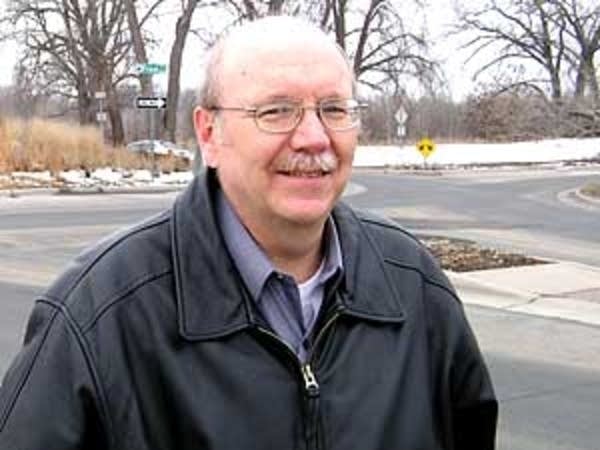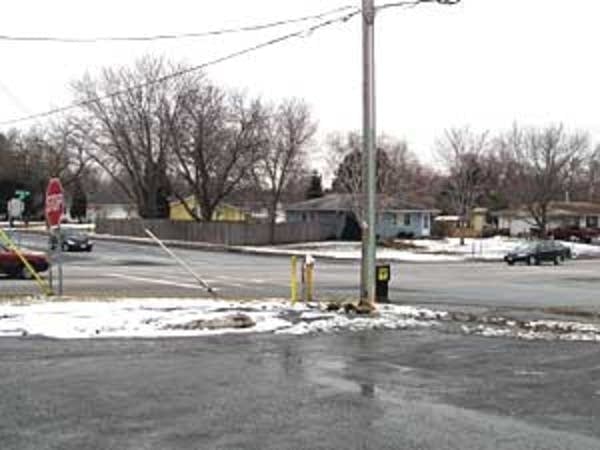Roundabouts coming to intersections near you
Go Deeper.
Create an account or log in to save stories.
Like this?
Thanks for liking this story! We have added it to a list of your favorite stories.

If roundabouts are a religion, Chuck Ahl is an evangelist.
His pulpit is a patch of sidewalk next to one of two roundabouts in the Twin Cities suburb of Maplewood, where Ahl is the public works director and city engineer.

"Now there's a bus slowing down and entering the roundabout. OK, now it's making the curve and it's through, and boom it's on its way and the intersection is clear again," Ahl says.
Like drivers, traffic engineers like to keep things moving. That's why a growing number of people like roundabouts.
Turn Up Your Support
MPR News helps you turn down the noise and build shared understanding. Turn up your support for this public resource and keep trusted journalism accessible to all.
Roundabouts are often confused with traffic circles common in the eastern United States. Such confusion is understandable, because both are circles with lanes of traffic around a center area with plantings.
But some traffic circles have stop signs while others don't. The result is a lot of driver confusion, resulting in traffic jams and even gridlock.
Roundabouts have yield signs. Advocates argue they keep traffic moving like a stream flowing around a boulder, with drivers merging and proceeding through an intersection.
How do you use them?

Ken Johnson, a design engineer for the metro division of the Minnesota Department of Transportation, and a roundabout advocate says it's pretty simple.
"As you come up to it, if there's a gap, go. If not, wait."
No red lights, no stop signs.
Johnson says drivers entering roundabouts have to yield, which sometimes means stopping for drivers already in them.
"The circulatory traffic has the right of way so they get to go and move, and the entering traffic has to wait for a gap to get into it," he says.

There are 10 roundabouts in Minnesota, with at least a dozen more in planning stages.
Wisconsin has more than 60 with many more on the drawing board.
Advocates like roundabouts for different reasons. Emergency personnel and insurance companies like them because crash rates at roundabouts are dramatically lower than at conventional intersections.
Chuck Ahl says the number of serious crashes at the Maplewood intersection is down sharply from the 10 recorded in the two years before the roundabout was built.
"We've had one accident in two and a half years," he says.
One reason for the improved safety is lower speeds.

Eagan assistant city engineer John Gorder says drivers have to reduce their speed.
"Traffic entering a roundabout will have to slow down to about 15 or 20 miles an hour. So at the traditional signal, traffic could hit this intersection at 45 miles miles per hour and keep on going," Gorder says.
Forty five miles per hour is the speed limit on Diffley and Rahn roads, where Gorder is standing. The intersection is controlled by four oversized red stop signs. During rush hours, Gorder says traffic backs up in all directions for at least one-quarter mile as drivers take turns on their way through.
Gorder says the intersection is nearly 20 years overdue for improved traffic control, and Eagan has decided to build a roundabout there instead of traffic lights.
Gorder says a four lane intersection controlled by lights can cost at least $500,000.
A roundabout will cost more, Gorder says, because the city will buy a couple of homes and a portion of a church parking lot to accommodate space needs.

Advocates argue over time, roundabouts save society money because there are fewer crashes and less property damage.
But that doesn't mean all drivers know how to use them.
"We've had to replace an inordinate number of bricks and lights," says Mike Corbin, who lives in Medford in southern Minnesota where he's a city council member.
Minnesota's first roundabout was built in Medford. Since then Corbin says nearly every light, planting and more than a few bricks in the center of the roundabout have been taken out by drivers who don't know what they're doing or who are driving too fast.
"We've had several trucks flip over, just tip right over and spill their cargo on the off ramp basically because...the drivers aren't familiar with the procedures for navigating a roundabout," he says.

Corbin is a roundabout advocate who says much more needs to be done to train drivers how to use them.
"My position since day one has been the state needs to take a greater role in educating drivers about what they are," he says.
Corbin's point is reinforced back at the Maplewood roundabout, where city engineer Chuck Ahl watches dozens of cars more or less successfully move through it -- until a blue pickup enters the roundabout and then does what Ahl calls the "Minnesota nice thing."
The driver stops in the roundabout to allow entry to a car waiting at a yield sign.
"That guy didn't operate correctly," Ahl points out. "He shouldn't have stopped. But he gave way. The other one went. Boom. Cleared out. Not a problem. But the guy in the roundabout didn't operate correctly."
Ahl and other advocates believe roundabouts work for a variety of reasons -- not the least of which is they can accommodate a range of driver behavior.
More Minnesota drivers will have a chance to test that view as roundabouts begin appearing at more intersections around the state.





